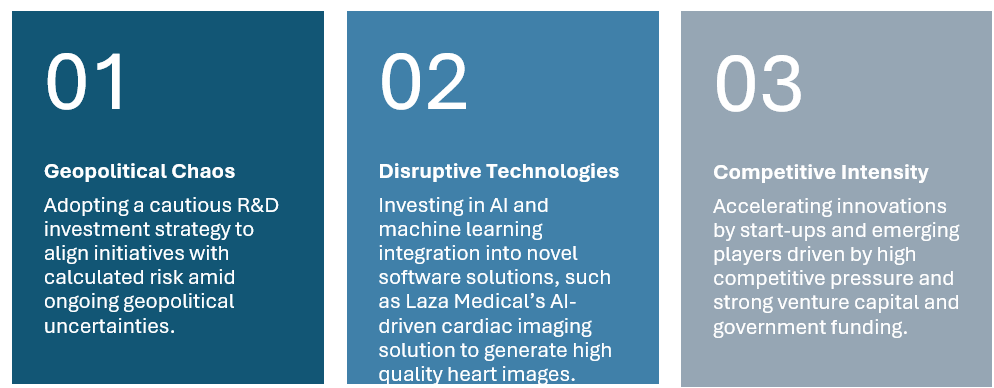The landscape of medical technology (MedTech) is evolving rapidly, driven by significant investments in research and development (R&D). As the industry recovers from the COVID-19 pandemic, new opportunities and challenges are emerging. This article explores the current trends in MedTech R&D investment and identifies key growth opportunities that can shape the future of healthcare innovation.
Explore MedTech R&D investment trends, M&A deals (2022), regional insights, and growth opportunities in our latest Frost & Sullivan analysis.
Current State of MedTech R&D Investments
Before the COVID-19 pandemic, the MedTech industry experienced substantial R&D investments. However, these investments declined during the pandemic but are now gradually regaining momentum. Leading MedTech companies are allocating approximately 7% to 8% of their total revenues toward R&D for novel and enhanced products. Other key sources of funding include corporate budgets, venture capital, private equity, government grants, and strategic partnerships.
The Complexity of MedTech R&D Spending
Investments in MedTech R&D are crucial for driving innovation. The complexity of R&D spending in this industry often surpasses that of traditional industries, such as consumer goods, due to the unpredictable nature of market demand. Major MedTech companies invest heavily in R&D to stay competitive and push for advancements in medical device innovations.
Focus Areas: Cardiology and Neurology
Two critical therapy areas—cardiology and neurology—are witnessing significant technological advancements and R&D investments.
Innovations in Cardiology — Investments in cardiology are primarily focused on:
- Artificial intelligence (AI)-based diagnostic tools
- Implant miniaturization
- Remote patient monitoring
- Minimally invasive surgical techniques
Key Players to Watch:
- MEACOR Inc.: MEACOR is Pioneering a transcatheter heart valve repair device that employs a minimally invasive technique to effectively stop valve regurgitation, improving patient outcomes in heart valve surgeries.
- Procyrion: Procyrion is advancing research for its innovative Aortix pMCS device that can improve heart and kidney function. The device implanted in the thoracic aorta increases perfusion to kidneys and decreases the heart’s load of pumping blood.
Advancements in Neurology — In neurology, R&D investments are concentrated on:
- Eye-tracking technology
- Implants
- Wearable monitoring devices
Key Players to Watch:
- Syntropic Medical (Austria): It is developing a brain stimulation device that utilizes light stimulation to treat drug-resistant neurological disorders, offering new hope for patients with major depressive disorder.
- NeuroBell (Ireland): It is developing a wireless pocket-sized brain monitor that utilizes AI to detect seizures in newborn babies admitted in neonatal intensive care units (ICUs).
What Key Strategic Imperatives Are Driving Growth in MedTech R&D Investments?
Key Goals of MedTech R&D Investment
- Innovate & Develop Products: R&D funds are crucial for creating solutions that meet unmet medical needs, such as minimally invasive surgical tools and AI-enhanced diagnostic devices.
- Improve Manufacturing Efficiency: R&D investments can enhance manufacturing processes, leading to improved efficiency and product quality.
- Develop an Innovation Ecosystem: Collaborating with startups fosters an ecosystem for continuous innovation and accelerated product development.
- Ensure Cost Savings: Integrating technology can automate processes, yielding significant cost savings for companies.
Growth Opportunities in MedTech R&D
- R&D Investments in Developing Countries: Economic uncertainties present compelling reasons for MedTech companies to explore investment opportunities in developing nations, which offer infrastructure and talent alongside high return on investment (ROI) potential. This shift is particularly relevant given the rising R&D costs and trade disputes in developed markets.
- Minimally Invasive Products: The demand for implantable devices requiring minimally invasive procedures is growing, driven by the need for patient comfort and quicker recovery times. Companies must invest in R&D to innovate miniaturized implants.
- AI Integration: MedTech companies should invest in the development of AI and its integration with medical devices, to achieve enhanced efficacy and improved patient outcomes.
The MedTech industry is poised for a robust recovery fueled by strategic R&D investments. By focusing on key areas such as cardiology and neurology, leveraging disruptive technologies, and exploring new markets, companies can capitalize on emerging opportunities. As the landscape evolves, MedTech firms must remain agile, innovative, and committed to enhancing patient care through groundbreaking research and development.
Explore our latest insights and detailed analyses for a comprehensive view of MedTech R&D investment trends and growth opportunities. Click here to download




